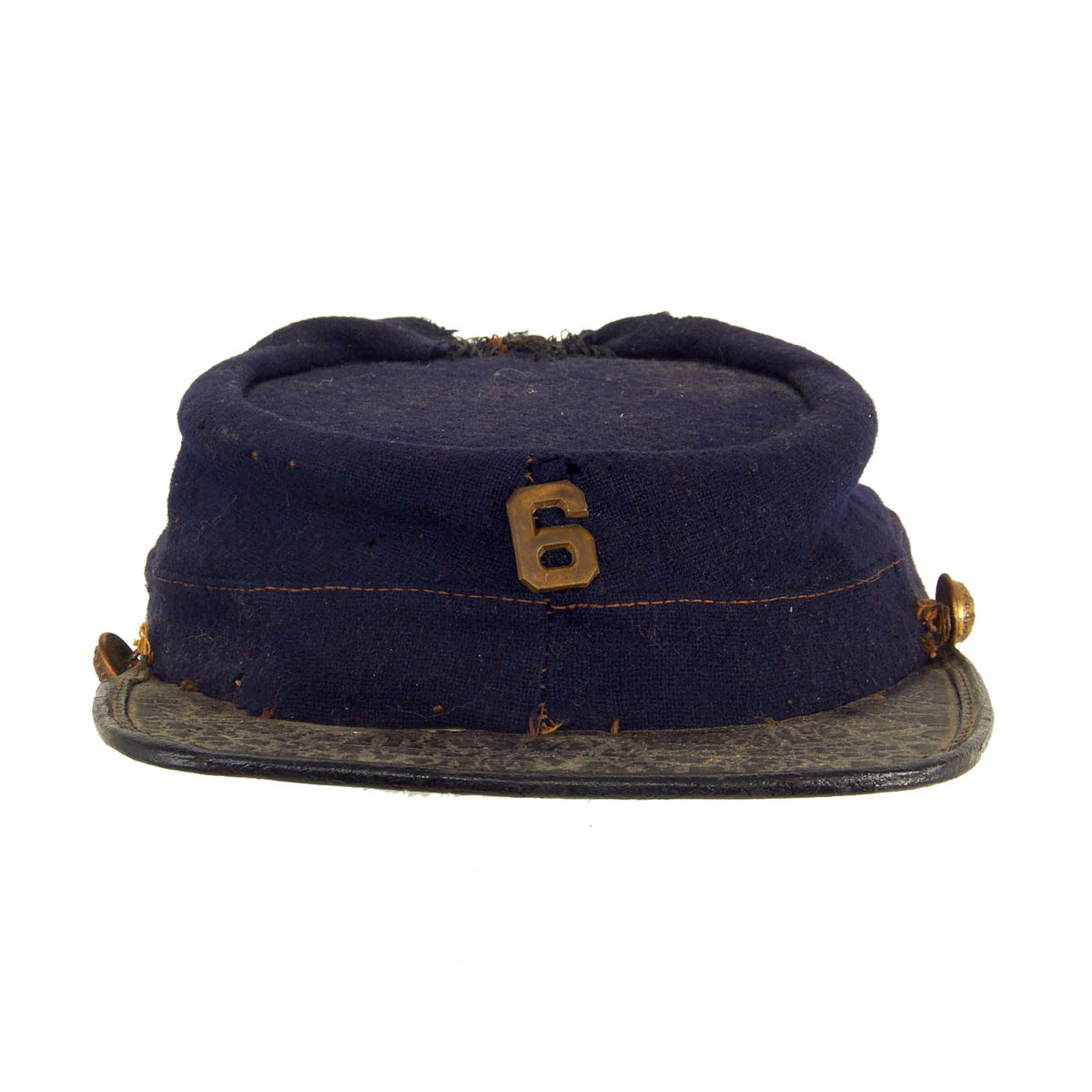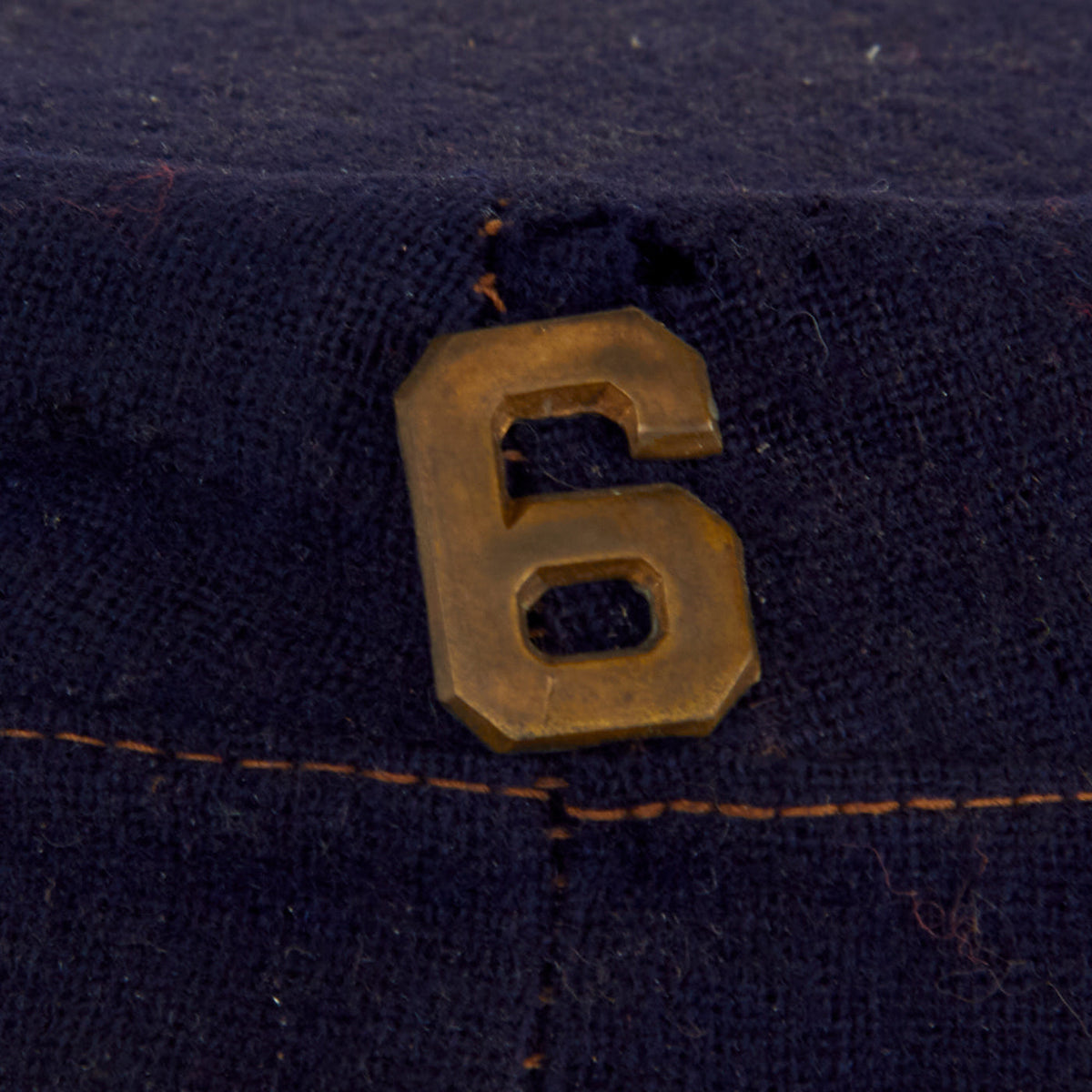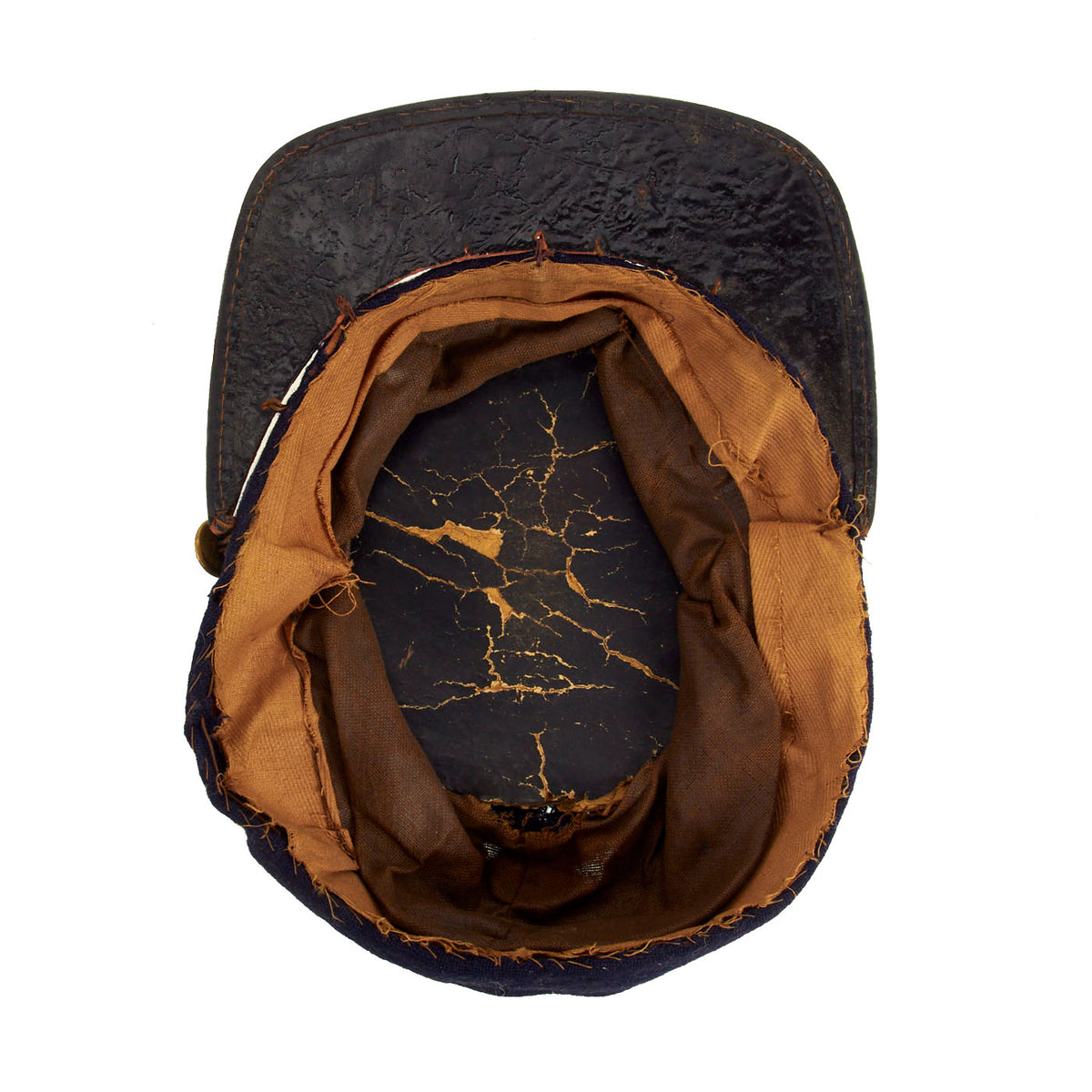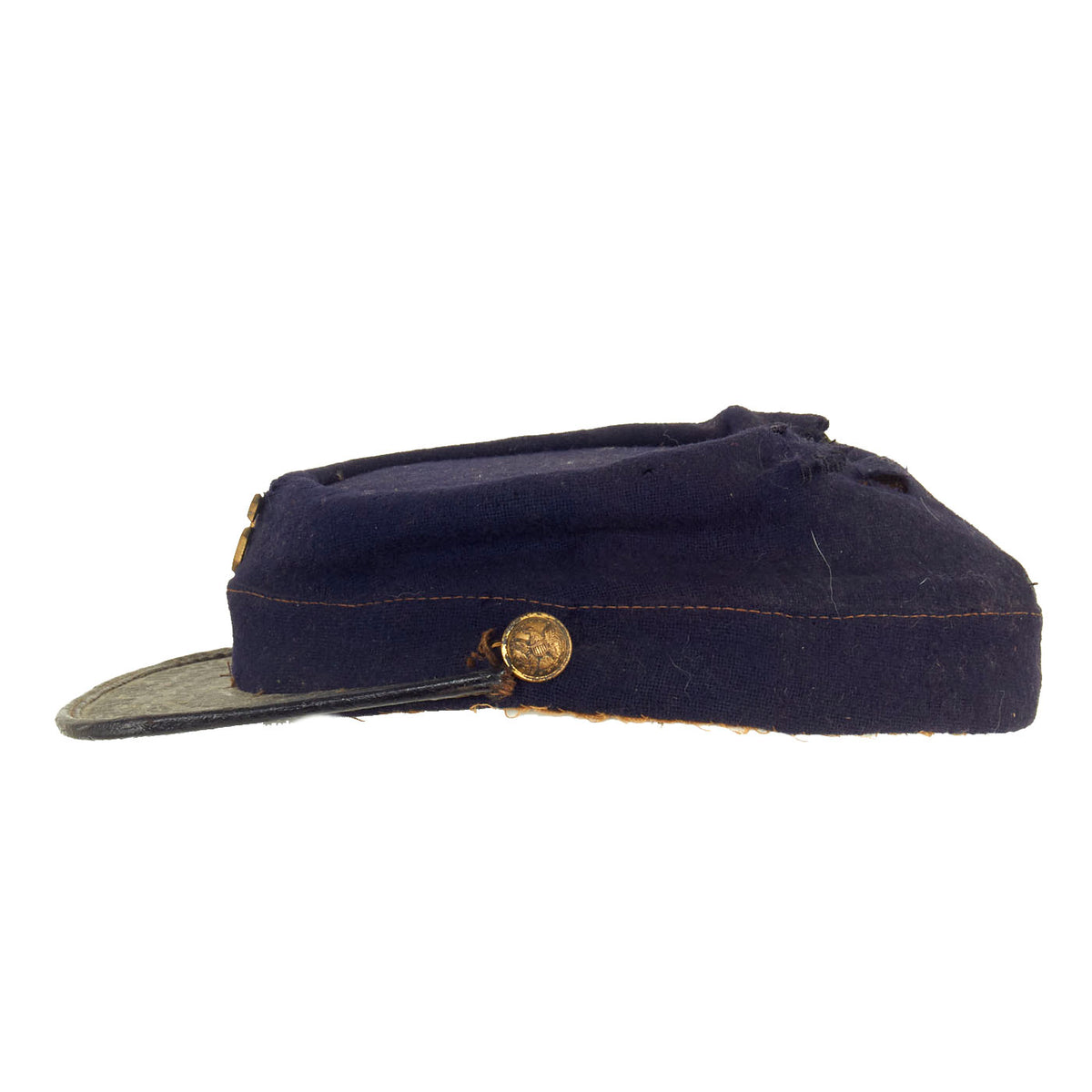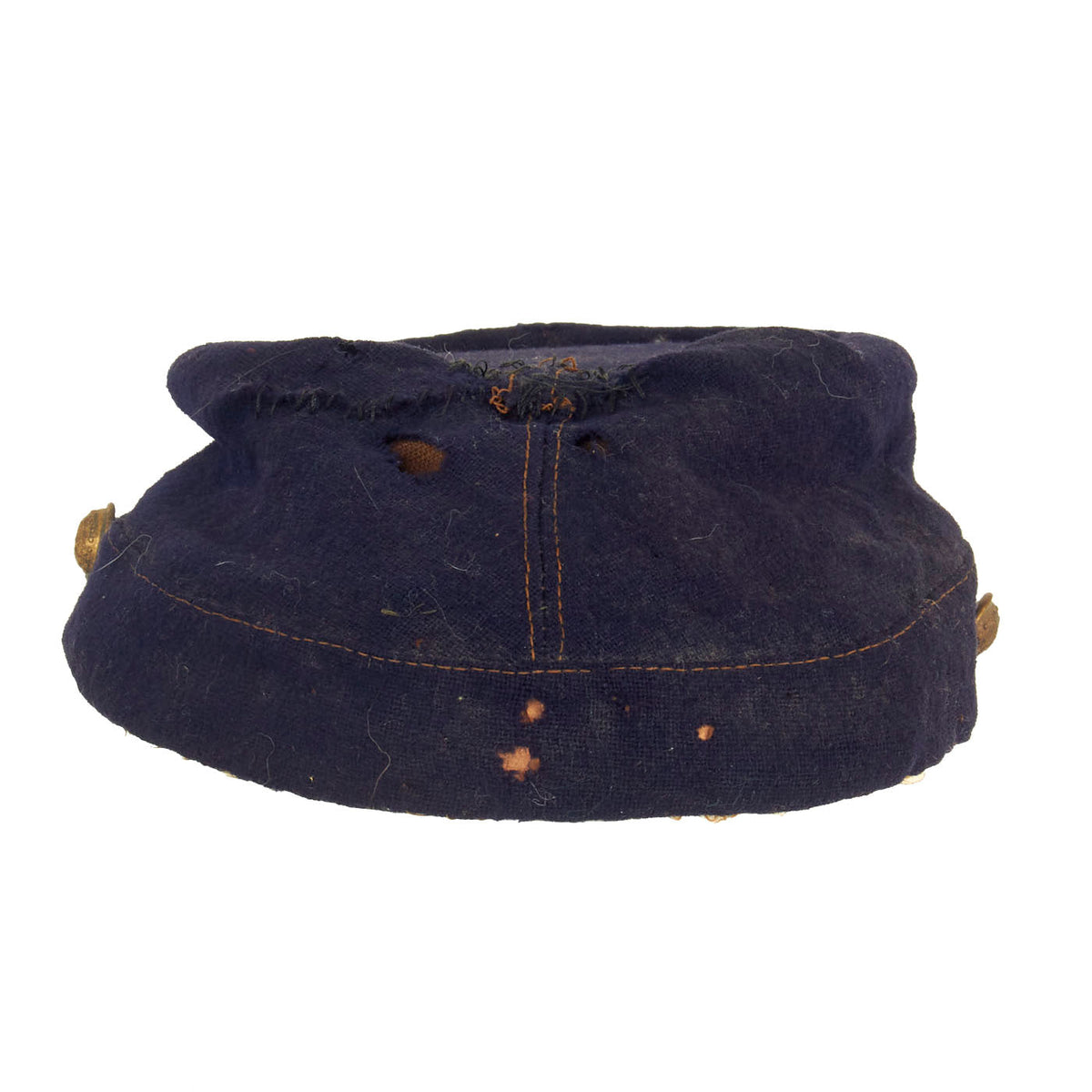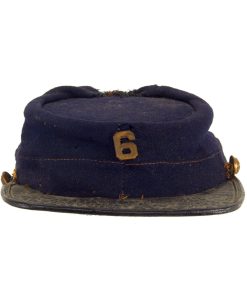Original Early Indian Wars Model 1872 U.S. Army 6th Infantry Regiment Officer Issue Kepi Original Items
$ 295,00 $ 118,00
Original Item: Only One Available. This is an excellent example of an early Indian Wars Model 1872 U.S. Army Regulation Kepi worn by an officer. This U.S. Army Model 1872 Kepi features fabric of dark blue wool broadcloth, with a painted leather visor with Brown polished cotton lining in the crown. The crown stands 3″ high at the front, 4 3/4″ at the rear seam and the top is 5″ in diameter. The body of the cap meets a band of wool seamed only at the back.
Many dealers would sell this cap as an original Civil War era piece, as the early Indian War M-1872 Kepis are very similar to those made and issued during the American Civil War.
This is a great cap, which shows signs of honest period wear, and wear from decades in storage. The visor is almost completely detached with old repairs done to keep it attached. The top back of the crown has old repairs done to the tearing, but we do not think these are period done. The sweatband and chinstrap are unfortunately missing. The side buttons are the correct 1875-1902 Staff Officer Buttons. Overall condition is nice, size is approximately US 7.
6th Infantry Regiment
The Sixth United States Infantry was born during a story period of American history, nourished on the ideals set forth in the Constitution and the Bill of Rights, and reached maturity on the battlefields of innumerable campaigns in 10 separate wars. It also has the distinction of having been commanded by Colonel Zachary Taylor, who later became the twelfth president of the United States of America. The present Sixth United States Infantry traces its lineage back to 11 January 1812, when the Congress authorized a strengthening of the regular Army in preparation for the threatening conflict that became known as the War of 1812. The unit was first known as the 11th Infantry Regiment and served as such on the Canadian border throughout the War of 1812 under Colonel Henry Atkinson. During this war it earned its first battle streamer – CANADA, in November 1813. On 5 July 1814, against the British at the Battle of Chippewa, British commander Major General Phineas Riall saw the gray coats of the soldiers and happily concluded that he was up against “Buffalo Militia.” Suddenly realizing that the Americans were coming through his artillery fire with unflinching precision, he blurted, “Those are regulars, by God!” The Regiment held the center of the American line against a gallant British charge, and so the regiment earned another battle streamer – CHIPPEWA. “Regulars, by God!” continues to this day to identify the soldiers of the Regiment. Later in 1814, the 11th Regiment inflicted heavy casualties on the British yet again, earning them the Campaign Streamer – LUNDY’S LANE. At the end of the war, on 3 March 1815, the 11th Infantry was consolidated with four other Infantry Regiments to form the Sixth United States Infantry Regiment. The new regimental number “6” was based on the fact that the commanding officer, Colonel Atkinson, was the sixth ranking colonel among all the regimental commanders of the United States Army.
As a result of westward expansion of America, the Sixth Regiment was assigned to the western frontier of the Nation. In March 1819, the 6th Regiment left Plattsburgh Barracks and floated down the Hudson to New York City. They sailed by transport to Philadelphia, then marched to Pittsburgh. In May, the expedition keelboated down the Ohio, then up the Mississippi and the Missouri to establish Cantonment Missouri at Council Bluffs on the Missouri River in September 1819. It became Fort Atkinson the next year. Once Cantonment Missouri was established, the expedition’s leader, Col. Henry Atkinson, was promoted to Brevet Brigadier General and transferred to St. Louis and district military headquarters. He was replaced by Col. Henry Leavenworth, a popular and much admired veteran of the War of 1812. The post’s only important military action began on June 18, 1823, when the keelboat Yellow Stone Packet arrived at the post bearing wounded and fleeing survivors of an Arikara Indian attack on the Fur Trading Company of William Ashley, on the Missouri River, in what is now north-central South Dakota. More than a dozen fur traders had been killed by the Ree, as they were commonly known, in a surprise attack. Ashley and the remainder of his party were holed up on the river and in need of aid. Colonel Leavenworth immediately ordered his 6th infantry troops to prepare for a campaign. Within four days he was headed upriver with 220 soldiers and 30 of Ashley’s survivors. Along the way he enlisted the aid of 80 white trappers and several hundred Sioux warriors who were more than happy to fight the Arikara, their traditional enemies. Before departing he sent the following message to General Atkinson at St. Louis: “We go to secure the lives and property of our citizens, and to chastise and correct those who have committed outrages upon them.” Leavenworth’s forces arrived at the Arikara villages on August 9, and a short, sharp fight ensued, which ended with the Indians abandoning their villages and escaping. Seven of the troopers were never to see Ft. Atkinson again, for they would become the first casualties of the Indian Wars of the west, which were to last until the 1890’s. This opening round of the Indian Wars of the west is commemorated by the battle streamer that flies to this day from the regimental colors of the 6th Infantry and reads – SOUTH DAKOTA 1823. On March 7, 1827, the Adjutant General of the Army issued the following orders: “The military post at Fort Atkinson will be abandoned and the 6th Regiment of Infantry will be stationed at Jefferson Barracks…”; and so the Regiment moved from Fort Atkinson to Jefferson Barracks, Missouri, where the city of St. Louis is now located. Two years later, four companies of the Regiment were assigned escort duty along the Santa Fe Trail, protecting traders and travelers, and the Regiment earned campaign streamer – KANSAS 1829. In 1831 and 1832, the regiment entered the series of actions to be known as the Black Hawk War, against the Sac and Fox Indians. On 2 August 1832, the 6th Infantry caught the Indians at the junction of the Bad Axe River with the Mississippi (in present day Wisconsin), and killed most of Black Hawk’s band (records say that 950 Sac were massacred), earning the Campaign Streamer – BLACK HAWK.
In 1837, the units of the Regiment left Jefferson Barracks for Florida via Louisiana. As part of a force commanded by Colonel Zachary Taylor, the Regiment entered the (Second) Seminole Indian War in eastern Florida in 1837. It was the first “guerrilla-style” war fought by US troops. It was a place that was cold and wet in winter, and hot and wet in summer; where only the Seminoles, alligators, snakes, and mosquitoes knew how to survive; and where dysentery and malaria were the primary rewards for Herculean efforts. There, the regiment won Campaign Streamer – SEMINOLE – for its actions near Lake Okeechobee. The Regiment remained in Florida until restoration of peace and then returned to Jefferson Barracks in 1842.
In 1843, Brevet Brigadier General Zachary Taylor became Colonel of the Sixth United States Infantry. The Regiment was attached to General Winfield Scott’s Army during the Mexican War in 1846 and through its gallant actions won five battle streamers – VERA CRUZ, CERRO GORDO, CHURIBUSCO, MOLINO DEL REY, and CHAPULTEPEC. The Sixth Infantry remained a part of the occupation army in Mexico until 1848 when it returned to Jefferson Barracks.
For the next ten years, elements of the Regiment were scattered over the Western Frontier, and saw duty in what are now the states of Kansas, Nebraska, Wyoming, Missouri and the Dakotas, against various Indian tribes. In 1854, elements of the regiment were sent to fight the Sioux Indians in the Battle of Ash Hollow in the eastern portion of the Nebraska territories, earning the regiment another streamer – NEBRASKA 1855. In 1857, the 6th Infantry fought and defeated the Cheyenne Tribe, and was awarded Campaign Streamer – KANSAS 1857. In January 1858, the Regiment made a grand march across the continent from Fort Leavenworth to the Pacific Ocean. Upon arrival in California, the Sixth was kept busy for the next several years scouting, marching, and operating by companies and detachments against the Indians in California and Arizona. During this time, the 1st Battalion of the Sixth Regiment was awarded the campaign streamer – NEVADA 1860.
At the outset of the Civil War in April 1861, the Regiment was directed to hurry eastward from California and join the Federal forces. According to one biographer of the time, “Several of the Regiment’s best and bravest officers, honest in the mistaken construction of the Constitution and true to their convictions as to their duty, had tendered their resignations and given themselves to the Confederate cause.” The Regiment was in California in April 1861. It was then concentrated in Washington, D.C., from October 31, 1861, to January 31, 1862. It was attached to Sykes’ Regular Infantry, Reserve Brigade, Army of the Potomac, until May 1862, and then the 2nd Brigade, 2nd Division, 5th Army Corps, Army Potomac, until June 1863. From there it was assigned to 1st Brigade, 2nd Division, 5th Army Corps, until August 1863, to Department of the East until May 1865, and District of Savannah, Ga., Department of the South, until October 1865. The Regiment began duty in the Defenses of Washington, D. C., until March 1862. From there it moved to the Virginia Peninsula, where it participated in the Siege of Yorktown, April 5-May 4, and Chicahominy Creek in Virginia, bringing Campaign Streamer – PENINSULA. From there it moved to Richmond between June 25 and July 1. The Regiment participated in the Battles of Mechanicsburg on June 26; Gaines’ Mill on June 27; Turkey Bridge on June 30; and Malvern Hill on July 1. The Regiment was at Harrison’s Landing until August 16, followed by movement to Fortress Monroe, and thence to Centerville August 16-28. It participated in Pope’s Campaign in Northern Virginia August 28-September 2, with the Battle of Groveton on August 29. The Second Battle of Bull Run followed on August 30, and the 6th was awarded campaign streamer – MANASSAS. Following that was the Maryland Campaign from September 6th to the 22nd. The Battle of Antietam, Md., was September 16-17, and brought Battle Streamer – ANTIETAM. This was followed by Shepherdstown Ford on September 19 and 20, and picket duty at Sharpsburg, Md., until October 29. Between October 29 and November 19, the Regiment moved to Falmouth, VA. Along the way it fought the Battle at Snicker’s Gap on November 3. From December 12th to the 15th, the 6th was north of the Rappahannock River overlooking Fredericksburg, Va., participating in a number of important engagements there, and earning campaign streamer – FREDERICKSBURG. That was followed by the “Mud March” January 20-24, 1863. The Chancellorsville Campaign followed from April 27-May 6, with the Battle of Chancellorsville May 1-5, when the regiment earned campaign streamer – CHANCELLORSVILLE. After Chancellorsville, the Regiment moved north into Pennsylvania, fighting the Gettysburg Campaign from June 11th to July 24th. At the Battle of Gettysburg from 1 to 3 July, the Regiment earned campaign streamer – GETTYSBURG. Pursuit of Lee occurred between July 4-24. Then the Regiment moved to New York City August 16-21, and thence to Fort Hamilton, N. Y. Harbor, with duty there until May 17, 1865. Between May 17th and 21st, the Regiment moved to Savannah, Ga., and had duty in District of Savannah, Ga., until October, 1865. During the American Civil War, the 6th U.S. Infantry Regiment lost during service 2 Officers and 29 Enlisted men killed and mortally wounded, and 1 Officer and 43 Enlisted men by disease. Total lost: 75.
For six years after the Civil War, the Regiment served at various stations in Georgia and South Carolina, and moved to Fort Hays, Kansas, in October 1871. For the next several years, the regiment saw duty on the frontier in Kansas, Colorado, the Dakotas, Iowa, Wyoming, Idaho and Utah. In 1872, the regiment was in the Dakota Indian Territory, fighting many engagements against hostile Indian forces. In 1872 and 1873, the regiment earned Campaign Streamers – NORTH DAKOTA 1872 and NORTH DAKOTA 1873. The next several years saw much action for the regiment during the Indian Wars, and they were awarded Campaign Streamers – MONTANA 1879, LITTLE BIG HORN, CHEYENNES, and UTES. In 1880, the Regiment moved to Fort Thomas, Kentucky, where it remained until called to action again in June 1898, in the Spanish-American War.
The 6th went to Cuba as part of the 1st Brigade, 1st Division, V Corps, and took part in the Battle of Santiago de Cuba, where it earned campaign streamer – SANTIAGO. Intense heat, terrible humidity, entangling obstructions, and the deadly, ever-present Spanish fire made this war a hell for soldiers accustomed to fighting on the Great Plains. On 1 July 1898, the Sixth Regiment took the brunt of the fighting during the charge up San Juan Hill, but carried its standard high and bravely, and always forward, and won the battle.
The Regiment then sailed in late July 1898 to the Philippines to help quell the Philippine Insurrection. The Moro tribe was one of the toughest enemies the 6th had ever faced – every one of them fought to the death, and preferred to do it in hand-to-hand style. The regiment fought over fifty engagements, and it left with Campaign Streamers for JOLO, NEGROS in 1899, and PANAY in 1900. In March 1905 the regiment returned to the Philippines to do battle with the Moros again. For three days in 1906, elements of the regiment fought in the Battle of Bud Dago, one of the fiercest conflicts of the entire island campaign. The successful ending to the battle broke the Moro strength and ended the fighting in that part of the island. It was at Bobong, Negros, on 19 July 1899, that a member of the 6th Infantry Regiment first earned the Congressional Medal of Honor. CPT Bernard A. Byrne of Newport Barracks, Virginia, was awarded the medal for most distinguished gallantry in rallying his men on the bridge after the line had been broken and pushed back. Following service in the Philippines, the 6th returned to The Presidio in California.
Fast Shipping with Professional Packaging
Thanks to our longstanding association with UPS FedEx DHL, and other major international carriers, we are able to provide a range of shipping options. Our warehouse staff is expertly trained and will wrap your products according to our exact and precise specifications. Prior to shipping, your goods will be thoroughly examined and securely secured. We ship to thousands clients each day across multiple countries. This shows how we're dedicated to be the largest retailer on the internet. Warehouses and distribution centres can be located throughout Europe as well as the USA.
Note: Orders with more than one item will be assigned a processing date depending on the item.
Before shipping before shipping, we'll conduct a thorough inspection of the items you have ordered. Today, the majority of orders will be delivered within 48 hours. The delivery time will be between 3-7 days.
Returns
The stock is dynamic and we cannot completely manage it because multiple stakeholders are involved, including our factory and warehouse. So the actual stock may alter at any time. It's possible that you may not receive your order once the order has been made.
Our policy is valid for a period of 30 days. If you don't receive the product within 30 days, we are not able to issue a refund or an exchange.
You can only return an item if it is unused and in the same state as the day you received it. You must have the item in its original packaging.
Related products
Uncategorized
Uncategorized
Uncategorized
Uncategorized
Uncategorized
Uncategorized
Uncategorized
Uncategorized
Australian WWII Owen MK1 Machine Carbine SMG Custom Fabricated Replica with Sling Original Items
Uncategorized
Uncategorized
Uncategorized
Uncategorized
Uncategorized
Uncategorized
Uncategorized
Armoured Fighting Vehicles of the World: AFVs of World War One (Hardcover Book) New Made Items
Uncategorized
Band of Brothers ORIGINAL GERMAN WWII Le. F.H. 18 10.5cm ARTILLERY PIECE Original Items
Uncategorized
Uncategorized
Uncategorized
